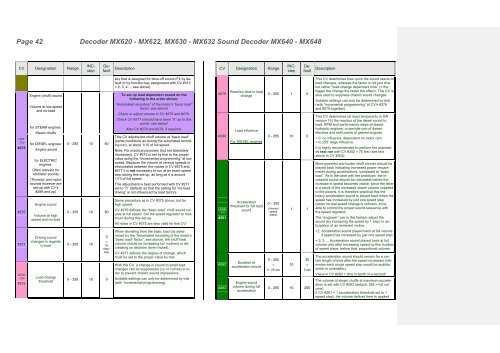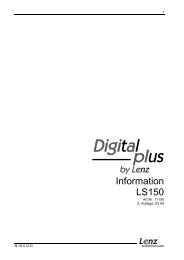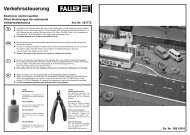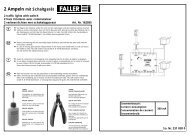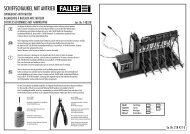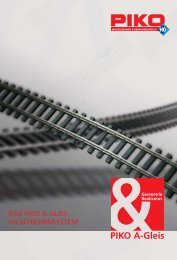INSTRUCTION MANUAL
INSTRUCTION MANUAL
INSTRUCTION MANUAL
You also want an ePaper? Increase the reach of your titles
YUMPU automatically turns print PDFs into web optimized ePapers that Google loves.
Page 42<br />
Decoder MX620 - MX622, MX630 - MX632 Sound Decoder MX640 - MX648<br />
CV Designation Range<br />
INCstep<br />
Default<br />
Description<br />
CV Designation Range<br />
INCstep<br />
Default<br />
Description<br />
LEIT<br />
- CV<br />
#275<br />
#276<br />
#277<br />
LEAD<br />
- CV<br />
#278<br />
Engine (chuff) sound<br />
-<br />
Volume at low speed<br />
and no-load<br />
for STEAM engines:<br />
Steam chuffs<br />
for DIESEL engines:<br />
Engine sound<br />
for ELECTRIC<br />
engines:<br />
Often relevant for<br />
ventilator sounds<br />
(Thyristor and motor<br />
sounds however are<br />
set-up with CV’s<br />
#289 and up)<br />
Engine sound<br />
-<br />
Volume at high<br />
speed and no-load<br />
0 - 255 10 60<br />
0 - 255 10 80<br />
Driving sound<br />
changes in regards<br />
to load 0 - 255 10<br />
Load change<br />
threshold<br />
0<br />
=<br />
no<br />
reaction<br />
0 - 255 10 0<br />
key that is assigned for blow-off sound (F4 by default<br />
or by function key assignment with CV #312<br />
= 2, 3, 4…, see above).<br />
To set up load dependent sound do the<br />
following in the order shown:<br />
“Automated recording” of the motor’s “basic load”<br />
factor; see above!<br />
Check or adjust volume in CV #275 and #276.<br />
Check CV #277 (should have been “0” up to this<br />
point), see below!<br />
Also CV #278 and #279, if required.<br />
This CV adjusts the chuff volume at “basic load”<br />
(same conditions as during the automated recording<br />
run), at about 1/10 of full speed.<br />
Note: For practical purposes (but not absolutely<br />
necessary), CV #275 is set by trial to the proper<br />
value using the “incremental programming” at low<br />
speed. Because the volume at various speeds is<br />
interpolated between the values in CV #275 and<br />
#277 it is not necessary to run at an exact speed<br />
step during this set-up, as long as it is around<br />
1/10 of full speed.<br />
This adjustment is best performed with CV #277<br />
set to “0” (default) so that the setting for “no-load<br />
driving” is not influenced by load factors.<br />
Same procedure as in CV #275 above, but for<br />
high speed.<br />
CV #276 defines the “basic-load” chuff sound volume<br />
at full speed. Set the speed regulator to maximum<br />
during this set-up.<br />
All notes in CV #275 are also valid for this CV!<br />
When deviating from the basic load (as determined<br />
by the “Automated recording of the motor’s<br />
“basic load” factor”, see above), the chuff beat<br />
volume should be increasing (on inclines) or decreasing<br />
on declines (even muted).<br />
CV #277 defines the degree of change, which<br />
must be set to the proper value by trial.<br />
With this CV, a change in sound to small load<br />
changes can be suppressed (i.e. in curves) in order<br />
to prevent chaotic sound impressions.<br />
Suitable settings can only be determined by trial<br />
(with “incremental programming).<br />
#279<br />
#280<br />
LEAD<br />
- CV<br />
#281<br />
#282<br />
#283<br />
Reaction time to load<br />
change<br />
Load influence<br />
For DIESEL engines<br />
Acceleration<br />
threshold for full load<br />
sound<br />
Duration of<br />
acceleration sound<br />
Engine sound<br />
volume during full<br />
acceleration<br />
0 - 255 1 0<br />
0 - 255 10 0<br />
0 – 255<br />
(internal<br />
speed<br />
steps)<br />
0 - 255<br />
=<br />
0 - 25 sec<br />
1 1<br />
10<br />
30<br />
=<br />
3 sec<br />
0 - 255 10 255<br />
This CV determines how quick the sound reacts to<br />
load changes, whereas the factor is not just time<br />
but rather “load-change dependent time” (= the<br />
bigger the change the faster the effect). This CV is<br />
also used to suppress chaotic sound changes.<br />
Suitable settings can only be determined by trial<br />
(with “incremental programming” of CV’s #278<br />
and #279 together).<br />
This CV determines (at least temporarily in SW<br />
version 15) the reaction of the diesel sound to<br />
load: RPM and performance steps of dieselhydraulic<br />
engines, cruise/idle rpm of dieselelectrics<br />
and shift points of geared engines.<br />
= 0: no influence, dependent on motor rpm<br />
= to 255: large influence.<br />
It is highly recommended to perform the automated<br />
test run with CV #302 = 75 first (see text<br />
above in CV #302).<br />
More powerful and louder chuff sounds should be<br />
played back indicating increased power requirements<br />
during accelerations, compared to “basic<br />
load”. As is the case with the prototype, the increased<br />
sound should be noticeable before the<br />
increase in speed becomes visible, since the latter<br />
is a result of the increased steam volume supplied<br />
to the pistons. It is therefore practical that the<br />
heavy acceleration sound is played back when the<br />
speed has increased by just one speed step<br />
(when no real speed change is noticed), to be<br />
able to control the proper sound sequence with<br />
the speed regulator.<br />
The “engineer” can in this fashion adjust the<br />
sound (by increasing the speed by 1 step) in anticipation<br />
of an imminent incline.<br />
=1: Acceleration sound played back at full volume<br />
if speed has increased by just one speed step.<br />
= 2, 3…. Acceleration sound played back at full<br />
volume only after increasing speed by this number<br />
of speed steps; before that: proportional volume.<br />
The acceleration sound should remain for a certain<br />
length of time after the speed increased (otherwise<br />
each single speed step would be audible,<br />
which is unrealistic).<br />
Value in CV #282 = time in tenth of a second!<br />
The volume of steam chuffs at maximum acceleration<br />
is set with CV #283 (default: 255 = full volume).<br />
If CV #281 = 1 (acceleration threshold set to 1<br />
speed step), the volume defined here is applied


